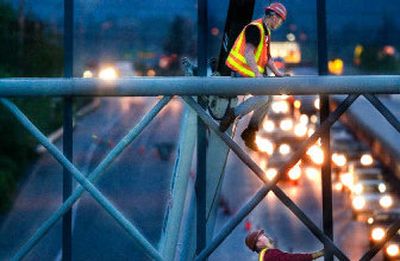I-90 work mapped out

When the clock strikes 12 and Sunday night becomes early Monday morning, the Interstate 90 viaduct construction ball rushes into full swing.
Crews will be madly racing to uncover signs and cover others. Traffic control workers will be blocking some downtown exits and on-ramps as other people will remove current freeway lane stripes so new ones can be painted.
Dozens of simultaneous tasks have been carefully choreographed to be completed within hours so that Monday morning commuters can find their way through the new traffic configuration.
It’s the kind of exercise that prompts visions of whirling dervishes spinning between pirouetting ballerinas and click-clacking tap dancers – all wearing reflective vests and hard hats.
“This job is very massive in scale at the beginning,” said Rich Stager, in-office project manager for N.A. Degerstrom Inc., which has joined with Acme Concrete Paving as the lead contractor for the viaduct work. “You obviously can’t do it all at the strike of midnight. You have to phase it in.”
Traffic control operations will begin at about 7 p.m. Sunday night, he explained, although exits and on-ramps will all remain open until midnight.
Ramps will be closed in sequence, one after another, at that time.
The entire operation is highly choreographed, but at some point you just have to trust the professionals to do their jobs, said Keith Peterson, the on-site project manager.
“The key is to delegate what you can to the appropriate person,” said Peterson. “They know what the job is. They know when it needs to be done and they will do it.”
That means many subcontractors, like Sharp-Line Industries, which handles signage.
Many of those signs are already being installed in preparation for the project, so they only have to be uncovered Monday morning.
“We have over 300 signs going up, and two crews working 10-hour days to get it done,” said Sharp-Line foreman Roger Williamson.
Drivers need to be alert.
“These first two weeks, in my mind, are the most difficult to schedule and create the biggest hazard for drivers and our crews,” said Stager.
Workers will be protected from traffic by cones and by construction vehicles parked behind where they are working, as well as special vehicles with cushioning barriers.
Over the initial two weeks, traffic will be reduced to two lanes in each direction, but remain on the current sides of the freeway.
That’s because crews must install barriers for the ultimate configuration where all traffic is moved onto what are now the westbound lanes, said Stager.
“Once the traffic is switched over into the chute, things will settle down quite a bit.”